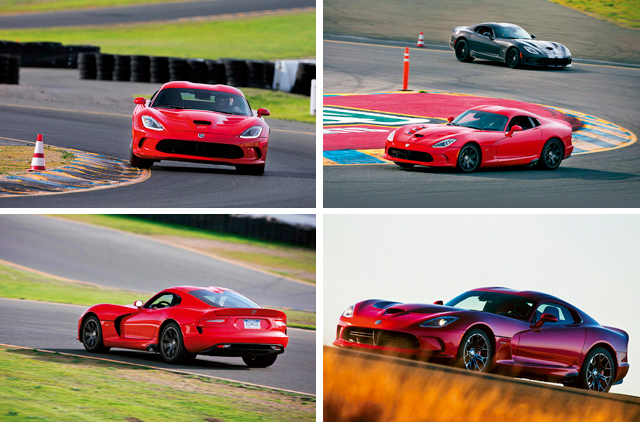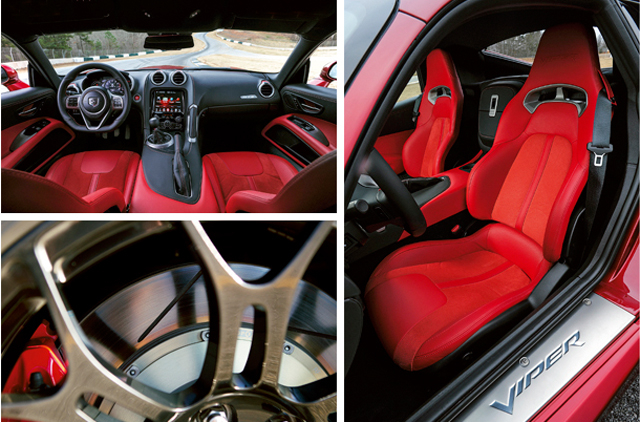
Somewhere amid the hiss of captive reptiles, the whir of spinning centrifuges and the crunch of freshly starched lab coats, a team of top researchers once proved that so-called ‘deadly vipers’ (the scaled wriggling kind) are able to calculate just how deadly to be. Step on a viper’s tail, and that might earn you a millilitre or two of venom, to which I say: ‘walk it off, Sally’.
But, if you serve baby vipers for dinner, Indiana Jones and The Temple of Doom-style, then a full dose of poison would surely be warranted, bringing your life to a swift end, while sparing you a nasty case of indigestion. Behind the wheel of the new SRT Viper GTS (note that SRT replaces Dodge here as the badge), a car as deadly as its namesake, you will also be faced with weighty decisions — only here the accelerator, clutch and brakes stand in for venom, jaw, and fangs, and it’s your job to make the decisions.
That’s not to say that the Viper isn’t an exceedingly safe car. Equipped with electronic multistage stability control, traction control, a new four-channel ABS system and advanced multi-stage front airbags with Occupant Classification System, the car has a formidable complement of safety kit.
It’s just that the sheer potential that SRT has packed into its new supercar should never fall into the wrong hands, although it would make a great super-villain car. I’m not saying that I have the right hands per se — piloting the Viper around Road Atlanta’s storied track, I came to the realisation that every motoring journalist must reach eventually: this car’s ability outpaces my own by several orders of magnitude. I’m having the time of my life, yet I feel vaguely like a hobo driving a Bentley or a bog-standard canteen cook trying to make a soufflé.
Approaching Road Atlanta, I would never have expected the passion that this old-school racing haven evoked. In this age of high-end race developments, the Road is something of a no-frills track, lacking the condos, posh restaurants, spa and pony rides endemic to modern racetracks. Instead, there’s just a sad-looking grill, a few port-o-johns and a tin awning with the unlikely name ‘hospitality chalet’ that looks like it might double for tractor sales during the week.
By the way, the grill looks like it may have been abandoned, but don’t worry, there’s plenty of petrol on tap if you get thirsty. This is racing at its no-nonsense finest, a nod to racing’s less commercial past and, while Road Atlanta might not have all the amenities for the wife and 2.5 kids, it makes up for its lack of shopping and Wi-Fi with blind corners, coiled turns and thrilling changes in elevation, making it the perfect playground for the budding snake charmer. And the Viper, like Road Atlanta, is slow to change, emerging from a multi-model-year hibernation to try a few newfangled gizmos.
For example, stability control has come to the brand new Viper for the very first time, it features Uconnect on a gorgeous 8.4in touchscreen for all your infotainment needs and a new driver-selectable two-mode suspension system — featuring Bilstein DampTronic Select shock absorbers with both street and track settings — is standard on GTS models. Digital control systems make modern supercars all the more super.
And yet this purist’s work in progress maintains its grip on old-school values in one important way. This non-boat from Detroit doesn’t sport any paddles, you’ll have to live with a six-speed manual if you want to feel the Viper’s bite (hint: you will). Oh, and when I say Detroit, I really mean Detroit proper, because this Motor City supercar is the only car made in the city limits — the other two Great Lakers just make trucks and SUVs in town.
On my first attempt at turn 10b — a wicked left-hander that destroyed the Nissan DeltaWing at Petit Le Mans this year in an accident that left Gunnar Jeannette uninjured, despite an extended upside-down jaunt across the tarmac — just as my track instructor guided me in his slow Southern drawl, I frantically tried to brake smoothly, downshift the car, listen to his story and hopefully stay on the road. It’s no easy feat.
Despite driving a five-speed manual fairly frequently, I’m wrestling with the Viper’s transmission ever so briefly. But I get the car into gear without incident, navigating the difficult section under the tutelage of a professional race instructor and, as if to reward my efforts, I’m presented with a high-speed pass at Road Atlanta’s ample backstretch. Sure, it could be more ample, but the SRT team has broken up the straight with a slalom section, knowing it will keep me well below the Viper’s 332kph top speed.
One thing is certain: I won’t be filling in for Jeanette any time soon, although my record on this track is, at least, a lot less expensive than his — in this business, we flatter ourselves that we can drive as well as we write, although perhaps that’s not always much to brag about... Back to the transmission; it’s not the car’s fault that it takes me a minute to acclimatise, as it really is surprisingly easy to shift once you’ve had a bit of practice.
The grabby clutch is oh-so satisfying when you’re hammering it down (yes, I’m up-shifting in this example, but the travel of the shifter is downward) into fourth on the straight, and there’s something quite primal about it — the roar of the engine jumps in pitch momentarily, sounding angry at the world, followed immediately by a satisfying snap of the neck, as the all-aluminium, 8.4-litre V10 re-engages with the gearbox to provide 640bhp and 814Nm of torque, unleashing enough fury to tear your eyebrows off.
It sounds like a long process, I know, but the crazy thing is that it all happens in a split second, a split second that, like so many of life’s great moments, seems like it lasts way longer in hindsight than a stopwatch would display. Maybe it’s not that surprising how fast things happen in a car with the most torque of any naturally aspirated sportscar engine in the world, but this is by far the most powerful sled that I’ve driven without paddles.
There’s no turbo lag here, only brain lag as the shift pattern of the Viper takes a little getting used to. I can drive your average manual transmission in my sleep, which makes commuting convenient, but the shift pattern of the Viper is tighter than what I’m used to — first gear on this six-speed ’box is somehow closer in, making it counterintuitive to the muscle memory I’ve cultivated around my own five-speed ’box.
I find myself flummoxed when I have to stop and think about what gear I’m in and where I want to go — if modern, ultra-fast autos have a real advantage, it’s that they suit my brainless approach to driving on the track — my analytical capacity evaporates as the siren song of the Viper’s howling exhaust note transforms me into a visceral creature. Even with 0-100kph acceleration in the low three-second range, there’s not quite enough room for me to get the Viper into fifth gear, let alone sixth, with this truncated version of the track, but that’s probably for the best.
The Viper will blow the doors off 99 per cent of the cars on Shaikh Zayed Road without going past fourth, leaving a pile of speeding tickets for you at the RTA kiosk. Good thing then that the braking distance from 100kph to a stop is just 32.3 metres. While the old Viper still holds a track record at the Nürburgring, the folks at SRT weren’t content to rest on their laurels while the model was on hiatus.
The 2013 Viper features an improved high-flow, lightweight composite intake manifold, high-strength forged pistons, sodium-filled exhaust valves, new catalysts to ease back pressure and an aluminium flywheel that reduces reciprocating losses. Oh, and it went on a diet too; approximately 11.3kg has been shaved from the aluminium V10. Navigating a section of track seemingly tailor made (and named) for the Viper, Road Atlanta’s famous “esses” section, the car’s balletic side-to-side motion (what body roll?) is underwritten by a stiffer structure that provides 50 per cent more torsional rigidity over the old model, handling aggressive lines with ease.
To achieve this, SRT placed a new aluminium x-brace under the bonnet that looks like something Professor Xavier would have on his personal wheels. Aside from looking cool, the brace marries the suspension pick-up points to the magnesium cowl super casting, which once again benefits torsional rigidity and stiffness — so I guess that’s one way that the Viper is unlike an actual snake.
A new aluminium impact beam on the front end also contributes to overall mass savings and improved weight distribution, helping give the Viper its 50:50 weight distribution (with a driver seated that is — it’s more like 49:51 without). The end result is that this snake has kept its skin but shed approximately 45kg, which culminates in a driving experience that is tough to beat.
Supercars are superlative in name and nature — if they are anything less than perfect, they shouldn’t be called super in the first place. There are many different shades of personality in a sportscar and, with its Detroit soul and supple Italian leather-clad interior, the Viper combines some of the best attributes of American and Italian cars — not surprising for an Italian-owned, Detroit-made rocket. Great things are afoot at SRT, and no car wears the badge more proudly than the all-new Viper, a car that any supercar freak will want to sink their fangs into.














